On a remote forestry road in northern B.C., a family keeps vigil. For the past month, members of Wilp Git’luuhl’um’hetxwit, a house group of the Gitxsan Nation, have spent day and night watching over a gate that they installed here in early May. Its purpose is to control access to their Lax’yip, or territory, and ensure any logging that happens there is done with consent from the house group.
The provincial government has told them to remove the heavy metal structure. “They call it an unauthorized gate,” Denzel Sutherland-Wilson says. On May 17, staff with the Ministry of Forests arrived with machinery to tear out the gate. Kolin Sutherland-Wilson, Denzel’s brother, turned them away.
“It’s not just about logging, or any environmental issue. It’s a sovereignty issue,” Denzel says. “We’re not protesting. We’re just a house group, living on our territory. It’s the most natural thing.”
Beyond the gate lies Git’luuhl’um’hetxwit traditional territory, which includes ancient trails used for berry picking and harvesting forest products. Some centuries-old stands, primarily cedar and hemlock, traditionally used by the Gitxsan are defined by researchers as “antique.”
Logging of old-growth forests has become a leading issue in B.C. since the province released an independent review of its management of old forests in September. At the time, it promised a new approach to forestry.
In the weeks that followed, protecting old growth became a major election issue, with Premier John Horgan promising to implement the report “in its totality.” More than seven months later, that hasn’t happened and cries to halt old-growth logging have only become louder.
Conflict over logging old growth on Vancouver Island has boiled over. As the number of arrests surpasses 150 and media are prevented from effectively covering the protests, Horgan promised Tuesday to “modernize” the forest industry. The announcement was panned as “an Orwellian nightmare.”
Horgan rejected calls for a deferral of logging in the contested Vancouver Island old-growth areas of Fairy Creek, noting the Pacheedaht First Nation supports it and saying the province is committed to respecting First Nations’ control over their territories.
“If we were to arbitrarily put deferrals in place there, that would be a return to the colonialism that we have so graphically been brought back to this week by the discovery in Kamloops,” Horgan said, referring to the discovery of the unmarked graves of 215 children on the site of the former Kamloops Indian Residential School.
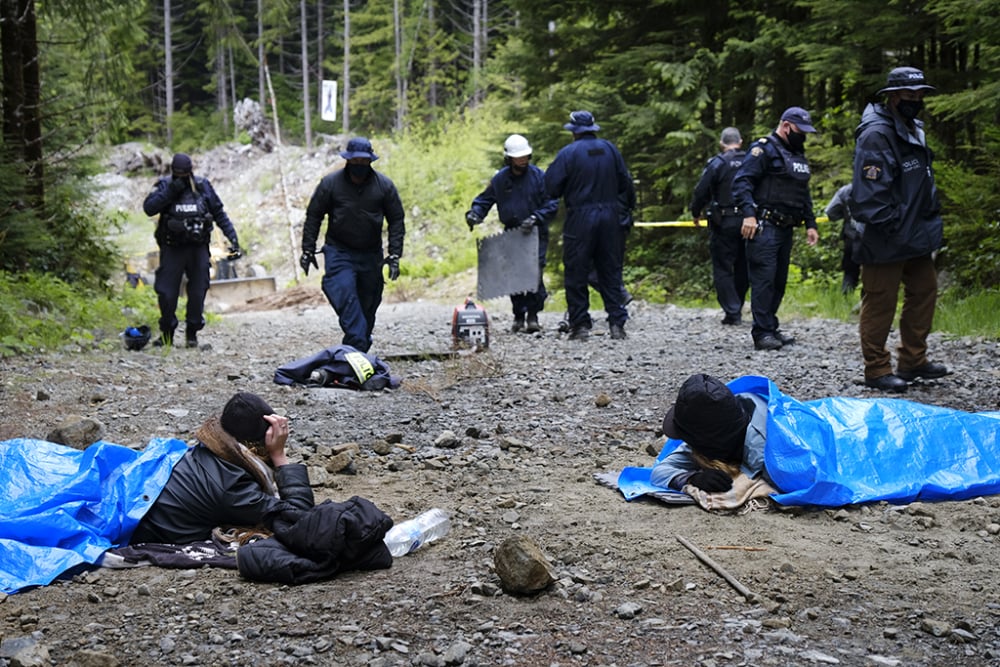
Critics pointed out that the province has not taken the same approach to Indigenous communities that oppose logging on their territories.
Like the Wilp Git’luuhl’um’hetxwit. More than a thousand kilometres north of Vancouver Island, on this spur of the Date Creek Forest Service Road, the air smells faintly of cedar and woodsmoke. Not far away, the Kispiox River meanders alongside the main forest road, passing Kispiox Village a few kilometres downstream before joining the Skeena River about 15 kilometres upriver from Hazelton.
Elders sit around the fire. Shubert Gunanoot pokes it absently with a stick, a blackened coffee pot at his feet. When asked if he’s here every day, Gunanoot gestures toward a tent pitched just off the road, under the thick cedar canopy: “You betcha,” he says.
At 1.3 million hectares, nearly half the size of Vancouver Island, the Kispiox Timber Supply Area is roughly 150 kilometres top to bottom and almost as wide. It surrounds Hazelton, extending north to the Nass and Prince George timber supply areas and south to the Bulkley area.
Currently, more than one million cubic metres of timber are permitted to leave the Kispiox area every year, the equivalent of about 25,000 logging trucks. But that number is under review.
The province’s own standards say timber supply should be reviewed at least every 10 years, with an updated annual allowable cut established by the chief forester. The last timber supply review for Kispiox was completed 13 years ago, in early 2008, after a year-long process.
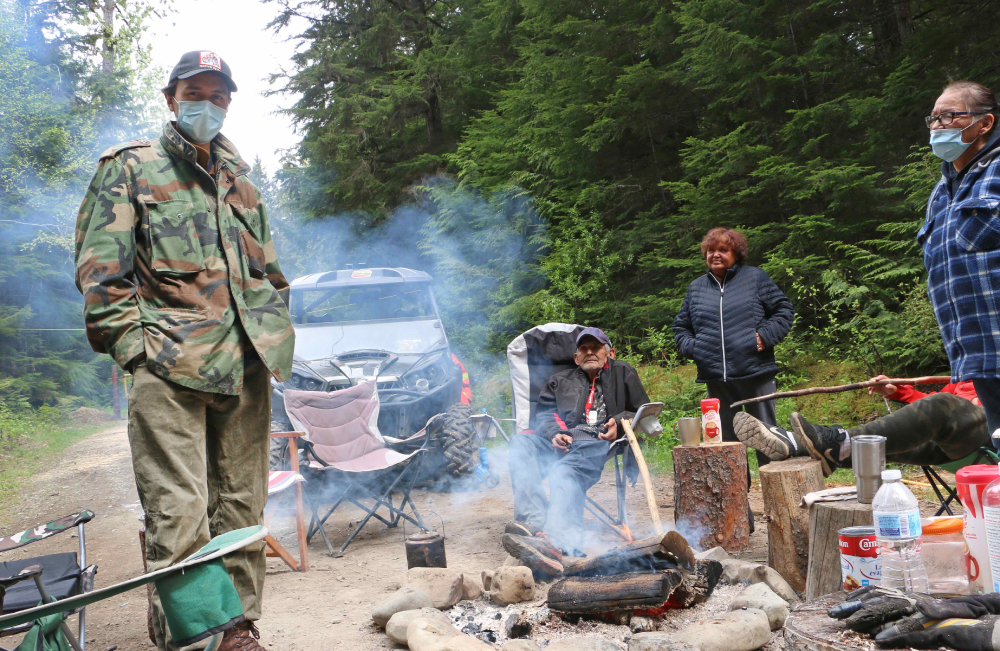
The province says it launched its current review in 2016. But the data package — a document that informs the process and provides fodder for public feedback — was just released in February. The public comment period ends in late June and a response from the chief forester is unlikely before late this year.
Meanwhile, logging in the area continues.
“I think the biggest problem is the province and the federal government don’t acknowledge us as landowners,” says Art Wilson. “Our lands have never been taken away from us.”
Wilson is the Sutherland-Wilsons’ father. He’s also Hereditary Chief ’Wii Muk'wilixw of the neighbouring Wilp Xhliiyemlaxha. He says he’s here to support this wilp’s house Chiefs, Chief Tsi’basaa (Leonard Gawa) and Chief Antgilibix (Rosaline Gawa).
“We respect actions taken by our fellow Chiefs,” Wilson says. “Their problems are our problems.”
Wilson remembers working with his grandfather to selectively log cedar here using a team of horses. Even further back, Gitxsan would traditionally peel a single plank from a tree, leaving the rest to continue growing. The area is full of trees scarred from past use, known as culturally modified trees.
“The beauty of this territory here is cedar,” Wilson says. Not only is the tree considered spiritually important, but it was used for necessities like canoes, bent boxes, baskets and clothing, he explains.
Wilson’s words are drowned out by the clatter of a flatbed hauling machinery down the nearby Date Creek main road.
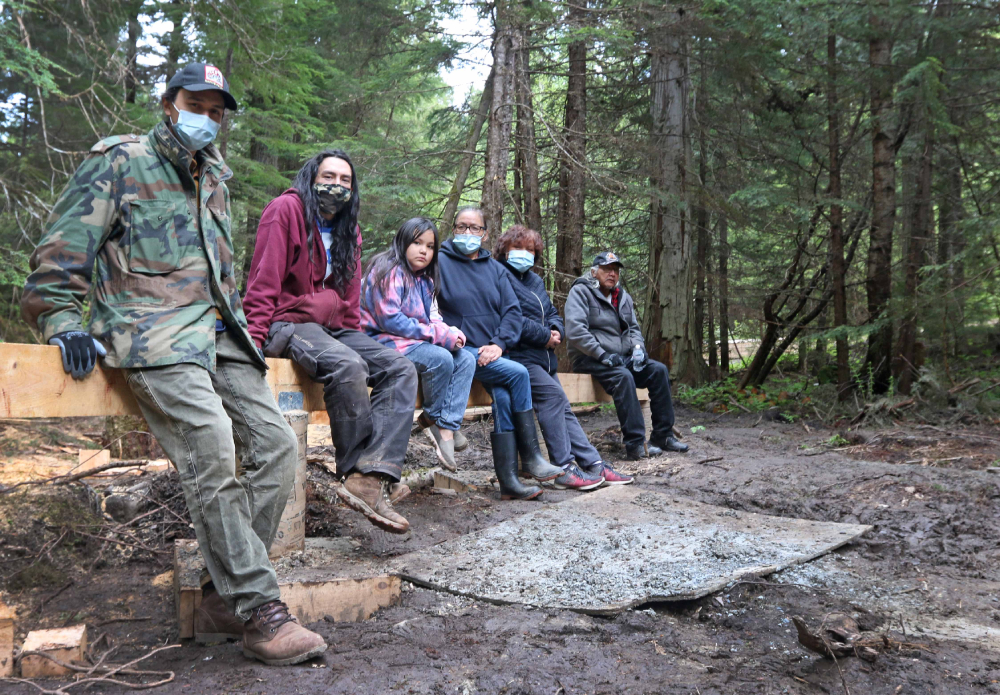
For decades, logging has been both a mainstay of the local economy and a source of conflict. Denzel remembers a time when the older generation was primarily employed by forestry. But those jobs dwindled as local mills closed and logs were trucked farther afield to Kitwanga and Houston.
Concerns over the extent of logging on Gitxsan territory led to roadblocks in the late 1980s. One of those was just down the road at Kispiox Village, home to about 550 people.
Aaron Croft grew up in Hazelton and experienced the roadblocks from the passenger seat of his father’s logging truck. Today, he owns Terrace-based Deuce Creek Contracting, the only operation to currently hold a provincial licence to harvest beyond the Git’luuhl’um’hetxwit gate.
The province has suggested he apply for a court injunction to remove the wilp members blocking access, but he doesn’t want to go that route.
“Yes, I’ve got money invested in it, but I’d rather let things go through due process and we’ll see what happens,” he says about the $20,000 deposit he put down on the timber licence. Requesting an extension on the permit could cost nearly that much again, he says.
Croft has lived here long enough to know the situation is complicated. The Ministry of Forests has a list of First Nations representatives that doesn’t always align with the wilp’s traditional governance. There can also be disagreements within the nation.
He’d rather see all parties sitting down at the table together.
“As far as I’m concerned, blockades aren’t very productive, because it just causes hard feelings,” he says. “The logger is always vilified, because you’re the one doing the work. But in the end, we have consent from the province.
“We just want to go to work, provide for our families, be home safe at the end of the day.”
But it was the blockades here in the 1980s that would lead the Gitxsan to court to defend their rights, alongside the neighbouring Wet’suwet’en Nation, in the decade-long Delgamuukw court case. In 1997, the Supreme Court of Canada would affirm that the First Nations’ title to their territories had never been extinguished.
Around the same time, Vancouver Island was seeing its first vocal opposition to the scale of logging in places like Meares Island in Clayoquot Sound. In 1993, in what has been called one of the largest acts of civil disobedience in Canadian history, nearly 1,000 people were arrested in what would become known as the War in the Woods.
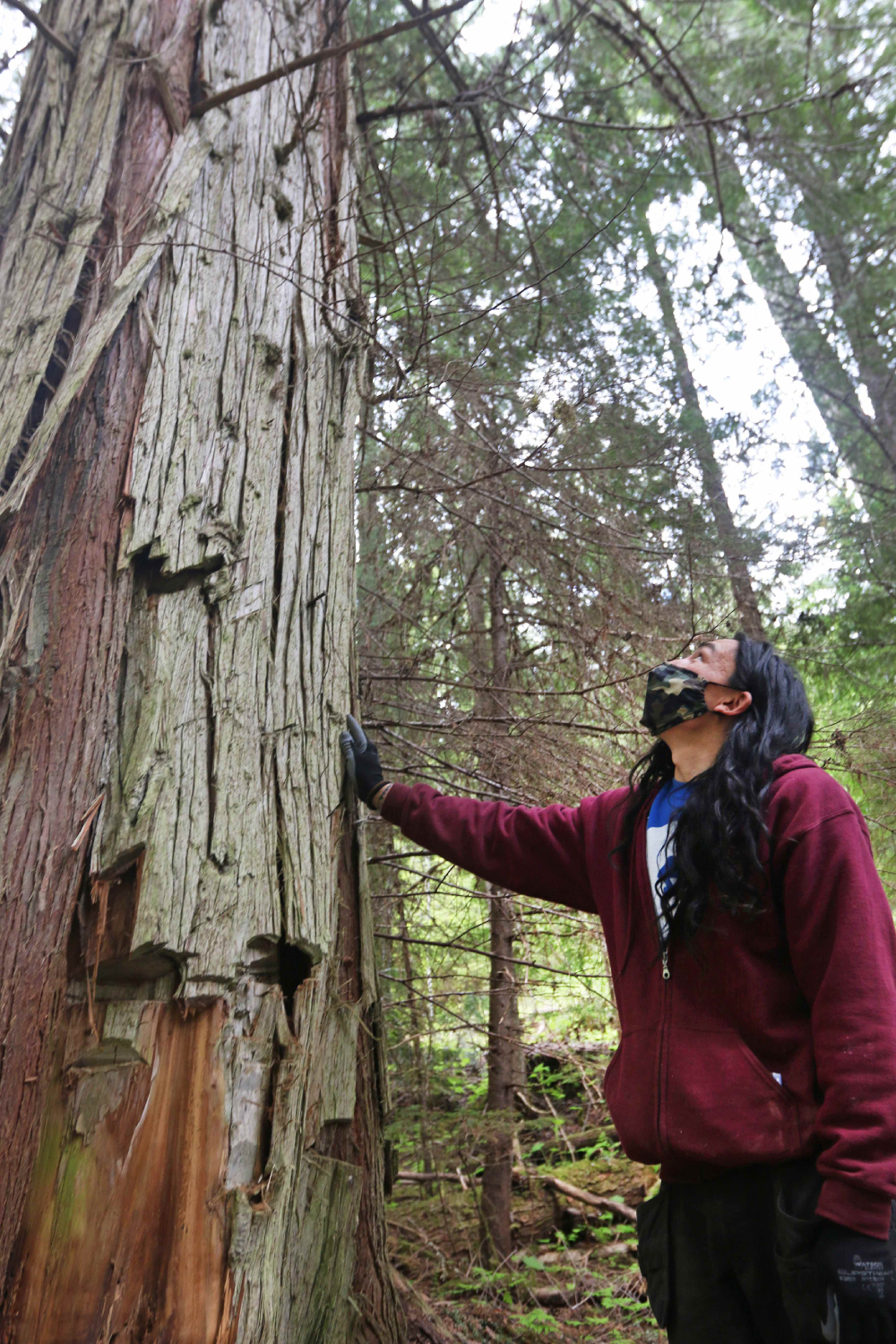
For a time, it looked like the War in the Woods might mark a turning point for B.C.’s forest industry. The BC Forest Service began funding research into alternatives to clear cutting, with experimental forests taking root across the province.
One of the biggest and most successful of those was Date Creek Research Forest, which was established in 1992 just up the road from Git’luuhl’um’hetxwit territory. In April, the province released a video about the research forest.
“The Date Creek experiment was a response to increasing public disapproval of industrial forestry in the 1980s in B.C. There was a growing interest in finding alternatives to large clearcuts,” the video says. The project allowed research that compared clear-cut logging with partial harvesting and unharvested forests.
Date Creek produced a large body of research that showed new ways of forest management, such as partial cutting, which selectively removed trees but left forests largely intact. But its methods failed to take hold in what retired silviculture researcher Dave Coates describes as the “culture” of B.C.’s forest industry.
“What’s been learned there has certainly gotten into the scientific literature and has certainly gotten into the teaching of students and teaching of graduate students. But it hasn’t had a major impact on forest practices in B.C.,” says Coates, who led the research at Date Creek for 20 years.
Just as the project was beginning to demonstrate the merits of partial cutting, the mountain pine beetle changed things again, he says.
The beetle epidemic “just destroyed any partial cutting that was going on in pine forests,” Coates says.
In an effort to salvage dead pine, the province turned its attention to clear cutting beetle-infected forests, taking the pressure off older, primarily cedar and hemlock stands in places like the Kispiox. But as the pine beetle harvest dwindled and the forest industry began to falter, governments again turned their attention toward older forests.
“Basically, the old approach came back, and we haven’t gotten rid of it yet,” Coates says.
B.C.’s Ministry of Forests, Lands, Natural Resource Operations and Rural Development declined interview requests from The Tyee. Instead, in an emailed statement, it says market conditions have meant that, on average, about 25 per cent of the allowable harvest has taken place in the Kispiox over the past decade.
“The most harvest to occur in any one year was in 2017 and was 41 per cent of the available [Allowable Annual Cut],” the statement reads. “The net effect of this is that harvest levels in the Kispiox have been well below sustainable levels.”
But much of that harvest has taken place in valley bottoms, areas where old-growth stands are most valued for their biodiversity.
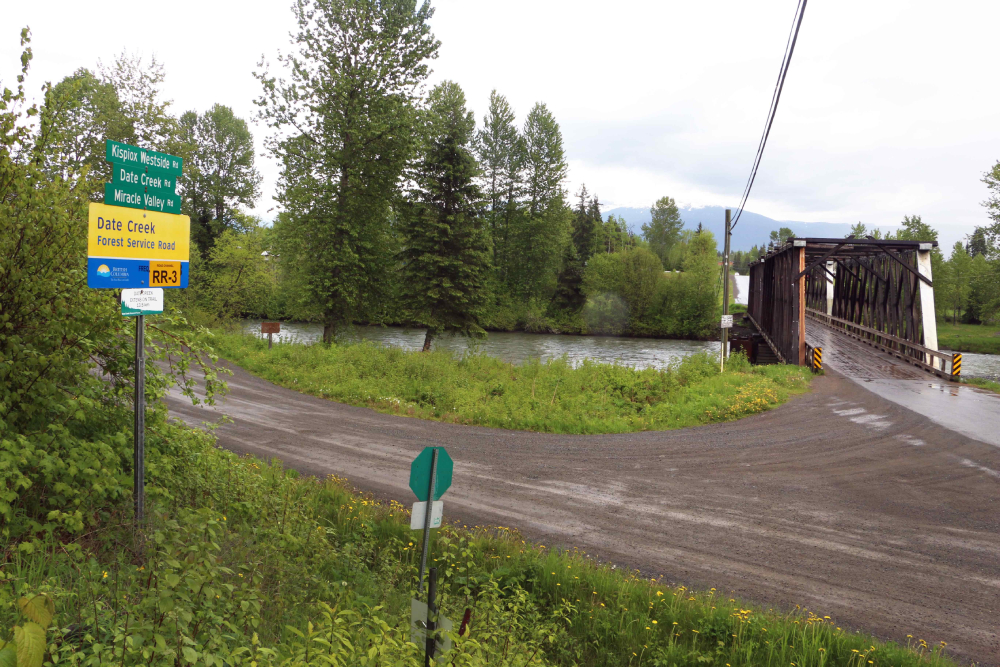
Paula Bartemucci’s research focuses on the conservation of rare lichens in the Kispiox Valley. She began working in the Date Creek area in the mid-1990s. By that time, many of the productive valley-bottom forests had already been logged in the 1980s and early ’90s.
“There’s a lot of old growth at higher elevations, but it’s less productive than the valley,” she says. “The valley bottom is more endangered.”
When found, lichens listed under the federal Species at Risk Act are protected within islands of old-growth forests in the cut block. Bartemucci says the province has been receptive to research showing the lichens need a wider buffer to survive, increasing it from 30 to 90 metres. But the islands still leave a patchwork of fragmented forests.
Some of those stands, Bartemucci describes as “older than old growth” — forests coined “antique” by researchers in the 1990s.
“Not surprisingly, antique forests are currently among the most endangered of the province’s ecosystems,” researchers Jim Pojar and Trevor Goward wrote in a 1998 paper on the Kispiox’s antique forests. “If only as archives of British Columbia’s biological past, they deserve special consideration as candidates for protected status.”
Date Creek sits within the transition between coastal and interior forests. About three-quarters of its forests took root 150 years ago, in the wake of huge wildfires that tore through the region in the 1860s. But there are pockets, found in wetter areas and gullies, that survived those fires. They date back 350 years or more, Coates says. Those are the stands considered “antique.”
Some of those antique stands exist up this Date Creek spur road, not far from Croft’s licence area. Their age makes them less economically desirable, with older hemlock notorious for heart rot.
Given climate change, biodiversity loss and the need for carbon sequestration, Coates believes the forests are worth more standing. As part of the Kispiox timber supply review, he’d like to see the chief forester implement the partial cutting techniques that were learned right here at Date Creek.
The Gitanyow Nation, to the west of Git’luuhl’um’hetxwit territory, also overlaps the Kispiox timber supply area. The nation is working with its Git’luuhl’um’hetxwit neighbours to provide a response to the area’s timber supply review.
Gitanyow also has a land-use plan in place that’s been signed with the province. Tara Marsden, a wilp member and sustainability consultant who worked with hereditary Chiefs on the plan, says it means that guardians are on the territory inspecting cut blocks and ensuring they align with the land-use plan.
She’s been talking to Wilp Git’luuhl’um’hetxwit members about creating something similar on their territory.
“If it can work in Gitanyow it can easily work in other areas,” she says. “We have the similar culture. We have hereditary Chiefs. We have similar values in terms of stewarding the territories and concerns around climate change and salmon.”
Marsden says that if the province has successfully managed the Kispiox area at just a quarter of its annual allowable cut for the past decade, there’s good evidence the maximum harvest could be permanently decreased.
“If all these companies can survive on 25 per cent, why cannot government reduce it to half?” she says.
This isn’t the first time Wilp Git’luuhl’um’hetxwit has objected to logging on its Lax’yip.
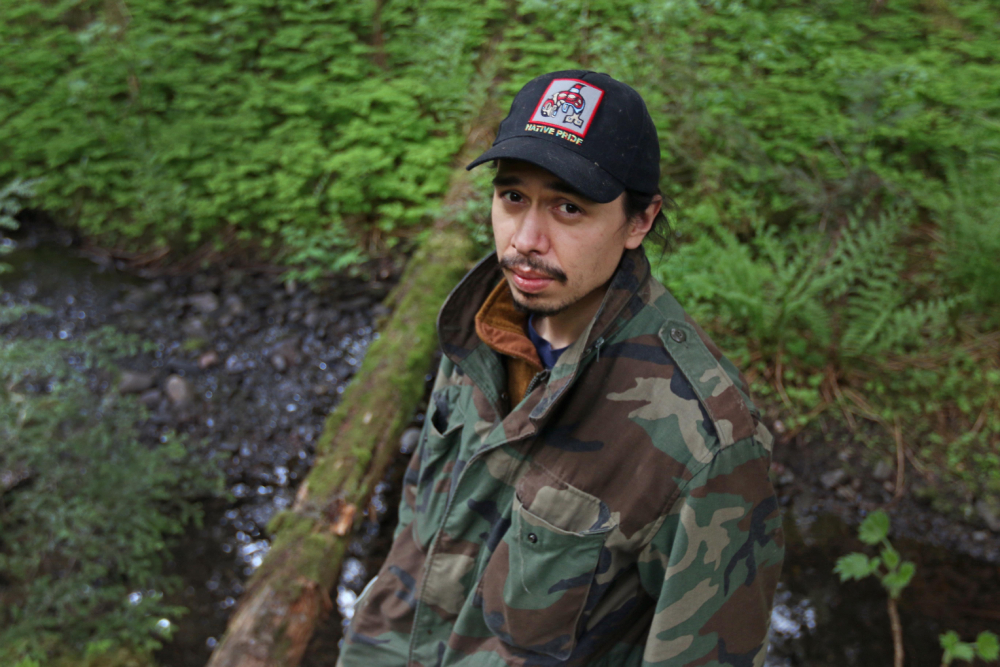
Gunanoot remembers a similar standoff here just three years ago. “I gave them 24 hours to get their machinery out of here,” the Elder says. “It took two weeks and they put an injunction on us and kicked us out of our own territory. We told them there’s no more cutting in there.”
But the current encampment feels permanent. People from the nearby village pop in for the day and children play beneath the cedars, learning the Gitxsan language and traditions. Not far from the gate, the family is building a cabin — a place where wilp members can gather on the territory.
This is where their ancestors lived before being moved onto reserves, Kolin says. “We’re just moving back.”
Wilp members plan to meet with the province this weekend. Otherwise, the Sutherland-Wilsons say they’ve had little information from the province about logging plans for the Lax’yip, other than plans to extend the existing forest road higher up the mountainside to tree line.
But he says wilp members are united against logging on the territory, something he says should come as a red flag for the province.
“Put it this way — our people had a relationship with this forest since the ice age ended and the big ice shelves receded,” Kolin says about Gitxsan stories that date back millennia. Kicking at the gravel, he speaks about the ancestors who lie in the ancient forests farther up the road.
“Our people are buried across this territory,” he says. “This dirt is our blood and bones.” ![]()
Read more: Indigenous, Local Economy, BC Politics, Environment



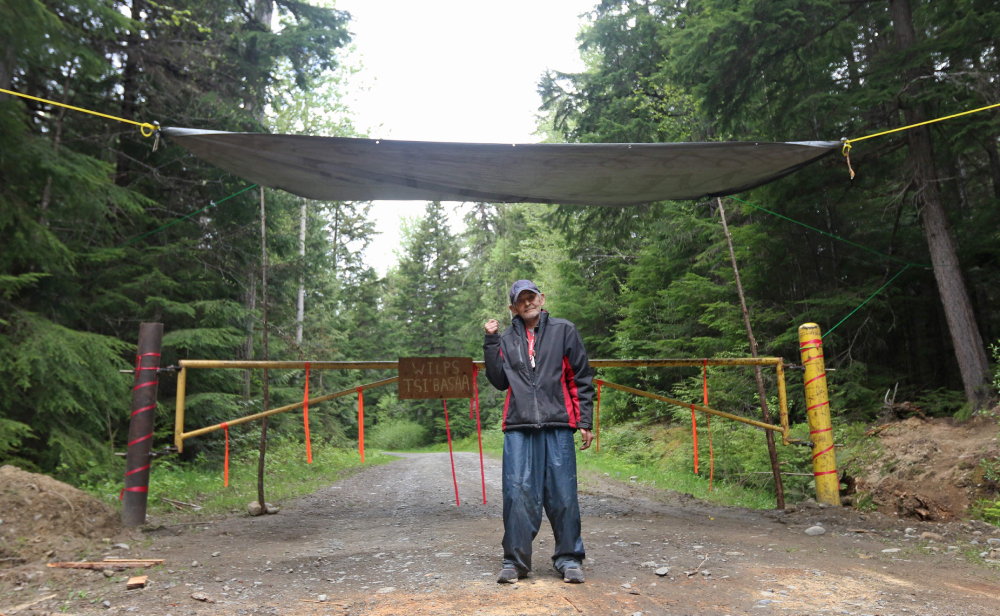












Tyee Commenting Guidelines
Comments that violate guidelines risk being deleted, and violations may result in a temporary or permanent user ban. Maintain the spirit of good conversation to stay in the discussion.
*Please note The Tyee is not a forum for spreading misinformation about COVID-19, denying its existence or minimizing its risk to public health.
Do:
Do not: